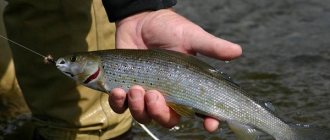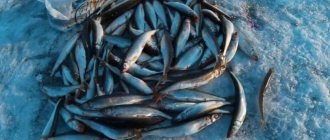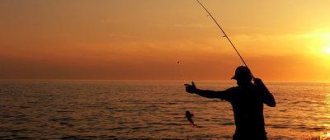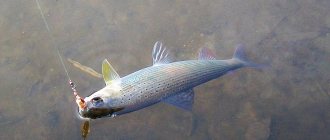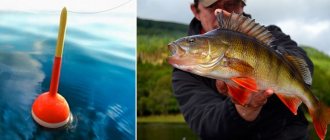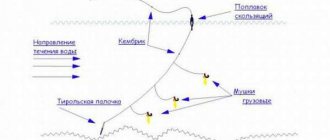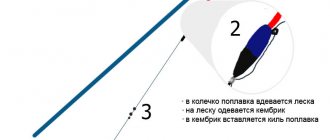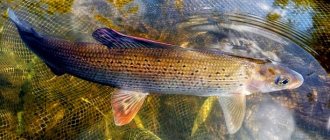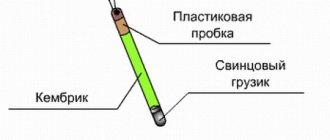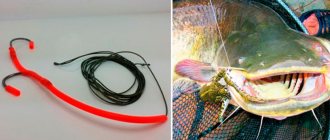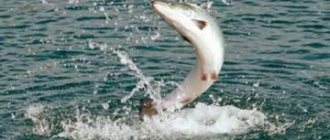Tackle for fishing grayling with flies
The fisherman can choose the appropriate gear based on his preferences; there are no requirements for a specific type. Beginner grayling hunters are recommended to use a fly fishing rod with a simple tackle design. The presence of the basic elements: a rod, for example, a Bolognese, a reel, fishing line, bait, makes it possible to start fishing, although you cannot do without mastering the casting technique. You should not choose heavy gear, which will lead to wrist pain. The optimal average weight of the rod is 350 g plus the weight of the reel.
Fly fishing rod
Gear that was previously used for hunting other inhabitants of water bodies is being re-equipped for grayling fishing. The purpose of the rig is to deliver the bait to the selected location.
Before choosing a fishing rod, you should decide what kind of fish and in what conditions you intend to fish. Hunting for large specimens and the presence of underwater plants require high-quality fishing gear. It’s worth studying the TOP middle-class fly fishing rods to choose the optimal model.
Spinning rod for fly fishing
Fans of spinning fishing who know how to equip a fishing rod catch predators throughout the open water season.
It is often possible to catch fish with a fly fishing spinning rod equipped with an inertial reel and a heavy float that acts as a sinker. Notifications about bites from the float are not required; it is necessary for making long casts, as accurate as possible.
The technique of fly fishing is to imitate the behavior of insects, to which the predator must react. The art of the fisherman lies in the realism of the presentation and the skill of casting. Gambling hunting involves the use of an elongated spinning rod.
In specific situations, casting distance may vary. An important factor is the absence of interference in progress on the surface. The cutting time is determined visually.
The equipment required for spinning is unusual. In addition to a special attachment, the required elements are a fly cord, backing, and a leash.
The semi-fly fishing technique is distinguished by the provision of wiring. Fishing using the bombard method is characterized by long-distance deliveries of ultra-light bait using Sbirullino-type floats.
Ultralight spinning rods are also suitable for fishing. No special wiring is required with it; the hunter’s task is to monitor the bites and hook in time.
Fly fishing gear diagram
Inertia coil
Fishermen in practice use both inertial and inertialess reels. The specific choice is determined by the fishing conditions, knowledge, and preferences of the hunter. The inertial version is more often used, since a light stroke does not create noise, it is easier to release the line by pressing the reel with a finger. The inertial reel allows the bait to float freely with the current. Experienced fishermen use additional spools.
fishing line
Grayling is known for its tenacity when fishing. The fighting fish resists despite the average weight of only 250 g; it may seem to the fisherman that there is a predator of at least 1 kg on the hook. Taking into account the nature of the individual, the correct selection of strong fishing line is required. It is recommended to use the monofilament version, since the elongation is better than that of fluorocarbon or cord. This quality helps to dampen the jerking of the fish during resistance. The shock absorption factor and soft rod will not allow the catch to fall off.
The suitable diameter of the main line is 0.24 - 0.3 mm. The leash can be made of fluorocarbon, 20 cm long, with a cross-section of 0.18 - 0.2 mm.
Tackle: “sleigh”, “boat” or “torpedo”
One of the ancient fishing techniques, unfairly forgotten, although the effectiveness of the gear is still maintained at a high level in different waters. Popular names convey the appearance of the floating gear. For manufacturing, any material that does not sink in water is required. Modern fishermen often use polystyrene foam or pieces of plywood. The design can be of any complexity - “catamaran ships” are made from one or several hulls. You will need a spinning rod of increased rigidity, an inertial type reel, and leashes of different diameters in the amount of 4-6 pieces. The leashes need to be attached at a distance of about 80 cm from each other. The casting of the tackle should be far, so that nothing interferes with free movement.
"Boat" for grayling
The floating structure floats downstream. Leads of various lengths are tied to the main strong cord, which allows all flies to touch the surface of the water. An exciting fishing method is used to catch large fish, which are usually very cautious.
Pull or bale
One of the ancient fishing techniques, feeding on the surface of a reservoir. The process involves two fishermen located on opposite banks. Everyone has a spinning rod, between which there is a fishing line, or “stave”, with long leashes, at least a meter, usually used up to three pieces. The line must be kept taut without bending.
Slow movement along the bank against the current is required. One angler is casting a fishing line, the other is fishing for a caught grayling. When dragging, when a bite occurs, you need to perform the hook synchronously. The diameter of the main line is 0.25–0.3 mm.
Catching with a drag
Preparing a fishing rod for grayling fishing
- Between the float and the hook, the length of the fishing line is determined in each case individually, depending on the depth in a particular area. If fishing is carried out at shallow depths (up to half a meter), the load moves towards the float. When fishing at a depth of 1 or more meters to the hook, but the distance should remain 15-20 cm.
- The float is selected to be light and small in size; an ordinary goose feather would be an excellent choice. It is worth noting that grayling takes the bait in different ways: it can suck it for a long time, quietly pull it to the side, or swallow it immediately. Hooking is performed only when the float goes completely under water. It is highly not recommended to use floats with bright colors, regardless of the depth at which the fishing is carried out.
- The fishing line on a float rod for catching grayling is set to a minimum cross-section; an excellent choice would be to use a fishing line with a diameter of 0.15-0.18 mm.
- As for the hook, it is recommended to use No. 4-6 with a short shank, made of wire 0.6 mm in diameter.
- For fishing, a rod 4-5 meters long is used; the choice of gear regarding the length should always be made based on the terrain conditions and the characteristics of the reservoir.
- Be sure to install a reel for the fishing rod with which you plan to catch grayling; a regular spinning reel with a spool size of 1500-2000 is suitable.
- The weight of the sinker is selected individually, but it is not recommended to use a load of more than 20 grams, as this will affect the sensitivity of the tackle.
Types of flies for grayling
Selecting the right bait is one of the most important tasks for an angler. The retrieve is not carried out at speed, so the grayling gets the opportunity to study the fly in detail. In order for the bait to be noticed, it is necessary to imitate the insect as accurately as possible. As a rule, models of discreet colors that are close in color to natural flies - gray, brown - become successful. But there are exceptions - sometimes bright insects are also actively working.
Varieties
The universal bait comes in a wide range. Anglers, if desired, will be able to make a fly themselves according to their needs, but the low price allows them to choose bait from proven models. Ease of installation and variability of gear with which the bait works are undoubted advantages.
There are two types of simulators that differ in basic performance characteristics - wet and dry.
Heavy front sight (wet)
Sinking models operate in the water column, which is why they are called wet, bottom models. In appearance, the imitators resemble insect larvae, tadpoles, mayflies, water beetles, and caddis flies. She has an oblong body, wings, and a sting.
"Wet"
Classic bait is heavier than water, more voluminous than dry counterparts. Mounting Features:
- knit wet on thick hooks;
- heavy bait requires sinking lines;
- during installation, wrap the hook with lead wire.
Heavy bait has proven itself well in the bottom layers. The most advantageous option is models of a gray-brown shade. In addition to grayling, the bait attracts salmon and asp.
Dry flies for grayling
Due to their low weight, they adhere perfectly to the surface. The resemblance to a real fly, butterfly, bumblebee or dragonfly is achieved with the help of feathers and various bristles. Modern materials allow you to get a realistic attachment. It looks like a wounded insect has fallen onto the water. Graylings are constantly attracted to flies in the water.
The bait does not submerge under water and retains its attractive appearance for a long time. Attaches to a thin hook. Dry fishing can be done throughout the season, from early spring to cold autumn.
floating
Streamers
The bait is designed for the predatory behavior of the inhabitants of the reservoir, as it imitates a wounded fish. The oblong body, fins, head - everything is recreated by the fry. Juvenile fish are found in almost all water bodies. Not prone to escape, it is an easy prey for trophy specimens. Not only large graylings exhibit predatory behavior, but also trout and pike.
Streamers for grayling
Fishing with a streamer between stones can be successful, where large inhabitants of reservoirs are often hidden in ambush among boulders, in “pockets.”
Nymphs
Baits that look similar to insect larvae at the formation stage, so-called nymphs, are relevant with the onset of summer. Works in the middle layers and at the very bottom. You need to select bait based on the characteristics of the reservoir, taking into account the realities of a particular region. The natural appearance, movements, and appearance at a given stage of development “convince” the grayling and other inhabitants of the authenticity of the appearance of the fly.
Nymph
Emerger
A type of larval imitator at the stage of transition of an insect to an adult. A universal option suitable for most fishing techniques. Medium-sized flies are suitable for hunting not too large grayling in the upper layer of the reservoir. The bait attracts even well-fed predators.
"emerger"
Fantasy
Unlike realistic imitators of well-known insects, fantasy specimens are not created based on prototypes, but are invented by the imagination of masters. Anglers use such flies when traditional ones do not work, as experiments. The preferences of the inhabitants of specific bodies of water may vary. An unexpected move by an angler with an exotic can be catchy.
Fantasy models
Which reel to choose - spinning or inertial?
Having experience in fishing with both types of reels when fishing for grayling, it is certainly impossible to say that this reel is much better than that one, since both inertia and inertia-free reels have their advantages. Accordingly, there are some disadvantages that need to be taken into account, and the best way would be to at least analyze live or via satellite the fishing conditions on the river on which you want to catch grayling.
In what cases does a spinning coil outperform an inertial coil?
First of all, where long-distance and accurate casting is needed, which is convenient to do with a spinning reel if the vegetation on the river is conducive to long-distance casting. The second big argument in favor of a spinning reel will be the presence of an adjustable friction brake, which well dampens the jerks of frisky grayling, thereby reducing the number of derailments when fishing.
Large grayling, as well as their smaller brothers, bite extremely sharply, the float goes under the water instantly without any play on the water, so in order to hook correctly, you must try to keep the line slightly taut at all times. With the help of an inertial reel, this can be done easily, since such a reel, when the fishing line comes off, itself tensions it; if necessary, the fisherman himself can hold the reel drum. An inertia-free reel throws the line off the spool without any tension, so it’s much easier to miss a bite with it, so for starters, based on my personal experience, I would recommend a small inertial reel, for example. Don’t forget that a spinning reel, as usual, after casting, turns the line into so-called wings - this is when the monofilament is twisted into turns due to the shallow spool. Due to the larger diameter of the drum, an inertial reel is less susceptible to this problem.
How to tie a fly
The correctness of the manipulations to correctly tie the fly to the fishing line affects the game of the simulator. You will need skills in connecting elements with popular fishing knots, since clips and carabiners turn out to be superfluous when fishing with artificial flies. This factor is explained by the fact that due to the low weight of the bait, all fastening elements lead to serious overload of the installations.
There are many knots for tying a fly to a fishing line:
- "Palomar";
- "Clinch";
- "Bloody Knot";
- "Uni" and others.
The choice is based on the perfection of the technique that the angler has, no matter what type, dry or wet, requires skill in tying knots. Using the example of the well-known “Clinch” connection, which is common for tying hooks, we can distinguish the stages of the connection:
- take the bait so that the ear is pinched with your fingers, the sting is directed downward;
- pass the line from top to bottom, cross to tie a knot;
- make 5-6 turns with the end of the fishing line;
- thread the end into the loop;
- tighten.
Reliable installation guarantees quality fishing.
Optimal hooks
The main characteristic feature of hooks for catching grayling on a float rod is a straight long fore-end, such as Owner hooks No. 56537, since grayling is an extremely greedy fish and can swallow a hook with bait right up to the gills, thus a long fore-end helps to quickly remove the hook with the help of small forceps or extractor. Hook sizes can vary greatly depending on the bait used, but generally range from #14 to #10 Owner's classification. However, recently, when I caught grayling on a float rod, I replaced the hooks with large jigs, which, due to their weight, do not require additional lead pellets. The weight of such jigs for grayling is about 1-2 grams, and the size of the hook itself is 10 and 12, the float should have the same loading weight. Grayling is not at all afraid of the jig, and even according to my observations, it bites more readily.
Fishing tactics
Ensuring good fishing is the behavior of the flies, which should be as realistic as possible. Using the most catchy model can be unsuccessful if a number of conditions in the fly fishing technique are not met:
- casts should be at long or medium distances, since grayling is known for its caution; it is not caught near a fisherman;
- movements in the direction and speed of the current should not be limited by the fishing line, free movement is the basis of the realism of the rafting;
- When guiding to potential prey, the cord must be tucked in, and maneuvers in the movement of the bait should be made natural.
The moment for hooking is any tension in the cord or unnatural movement of the bait, which the angler determines visually. Grayling offers strong resistance, for which you need to be prepared. Regardless of the size of the fish, the fighting qualities of the inhabitant are always at their best.
The fisherman needs to give up high-speed fishing and choose the technique of constantly holding on a tight line to tire the fish. Only after calming down, catch it in the landing net.
Features of fishing in small rivers
In cramped conditions, it is easy to alert the fish with any sudden movement or noise on the shore, which is clearly visible from under the water. Good camouflage means a lot. The cast should be made slightly above the intended habitat of the grayling, so that the presentation of the fly with the current is realistic.
Fishing for grayling from the shore
After vigorous fishing, you should no longer expect a bite in the same place. A frightened flock of relatives will probably move downstream. Accordingly, the cast should be to a new place. You can return to the old way after some time.
Hunting tactics on medium rivers
On reservoirs with plenty of room for fishing, the most successful areas will be the zones between fast and quiet water. It is recommended to take into account the natural food supply, which may interfere with hunting on artificial flies. Grayling appear on the rifts at the beginning of summer and stay almost until the beginning of autumn, but large individuals go downstream first. The best feeding areas for fish are at the end of the riffle.
Fly fishing is exciting; you need to have enough types of bait in your arsenal to experiment. Grayling, although cautious, is at times voracious, which contributes to an excellent bite.
Types of equipment
To catch grayling using a float, you can use different equipment that differ in individual parts and elements. According to the principle of action there are:
Grayling rig with float
Any monofilament or fluorocarbon fishing line with a thickness of 0.16–0.2 mm is suitable for mounting the equipment. Sliding or stationary weights are placed on the main thread, then a leash 30–70 cm long is tied, depending on the fishing conditions. Then comes the undercut at a distance of 5–20 cm from the single hook.
Such equipment is relevant in the summer during the period of mass emergence of various semi-aquatic insects, early spring, autumn and even winter, when grayling is inactive, stands near the bottom, feeds exclusively on benthic invertebrates, mollusks and small crustaceans.
Equipment without float
Floatless equipment is used in fast currents when the fish is standing at the bottom. Tackle diagram:
When fishing, the equipment works like this. The fisherman places a worm, maggot, or insect larva on a hook and throws it into the water. The sinker sinks to the bottom, and the leash sways due to the influence of the current on it. After 5-15 seconds, the rod is twitched slightly so that the weight rises and jumps to the next point.
Features of fishing by season
Many fishermen open the grayling hunting season in early spring, after the rivers have completely opened up. In the period before spawning, usually in April, the water is already warming up, and the fish begin to feed especially actively at the surface. There are not as many insects as there are in summer, so interest in artificial flies is higher.
Spring
Spring fishing can be done with classic spinning rods and other types of fishing rods. The fly fishing technique with sinking flies and bombards is especially effective on small rivers.
Surface fishing is more effective in clear water, but not all anglers correctly determine the degree of transparency to select a suitable simulator. To avoid mistakes, you can use a proven method: go into knee-deep water. See if the toes of the boots are visible. If they are clearly visible, then flies on the surface will work. Experienced fishermen note that if suspension is present, it is better to choose models of bright colors to attract attention.
Summer
Summer hunting for grayling is still successful with light, sinking flies, if you correctly identify the places where fish accumulate. Usually these are areas with underwater vegetation, whirlpools, areas where the bottom is not visible.
Autumn
In autumn, the location of grayling changes; a period of migration begins from small bodies of water to larger ones, gradually approaching wintering areas. Fishing in streams and small rivers will be a futile activity. The duration of the fishing season significantly depends on weather and climatic conditions, but usually the bite lasts until the end of October. A special feature of fishing is the use of heavy flies that attract grayling in the water column. Surface models do not work as the fish feed at depth.
Types of spinning rods
To catch grayling, light, ultralight and universal forms are used. The main thing is that they make quality casts with miniature baits and have a decent power reserve. You need to take the rod with a comfortable grip that does not cause tension in your hand. This kind of fishing usually takes place in reservoirs overgrown with bushes or surrounded by trees. They become an obstacle to casting and retrieving. Therefore, you should not purchase long spinning rods. Short forms in this case are more convenient. It is necessary to select models that work with coils ranging in size from 150 to 250 millimeters. A good option would be Daiwa and Shimano models designed for grayling hunting. In the cold season, it can be caught using mino and crank bait.
Bait selection
When choosing a working bait for grayling, as when catching any other fish, you need to take into account what time of year it is, what the grayling prefers to eat, and what living creatures live in this body of water. Despite the fact that grayling is a very voracious and omnivorous fish. One of the best baits for catching grayling is a caddis fly larva, which lives in large numbers on the micro-river. You should look for houses with larvae on rocks and tree branches lying in the water. At the beginning of summer, when the caddisfly is a larva living in a cocoon, fishing for grayling is one of the most effective, but closer to July, the houses in which the larva lived are already empty.
At the height of summer, the caddisfly can be replaced by a gadfly or grasshopper, and the grayling itself begins to actively feed on flying insects. You can guide insects both in the water column and along the surface, lowering them downstream. Throughout all the years that I have been catching grayling on a float rod, my universal bait has been a large earthworm or dungworm, which is easy to find or buy, and it is also all-season, since you can be guaranteed to catch this lively fish with it at any time. And here the saying fits perfectly: “a big piece makes your mouth happy,” so I always attach 2-3 large worms, thereby using fairly large hooks up to number 8. And finally, don’t skimp on the bait, since the grayling’s mouth is wide, and the fish themselves are very greedy, so five caddis flies or a bunch of worms will not scare the fish, but on the contrary will attract, especially large grayling.
Grayling is a very cautious fish, but not at all capricious, and if you follow all the basic recommendations and advice that I wrote about above, you can catch this undoubtedly one of the most beautiful freshwater fish in our country with a float rod very successfully throughout the open water season. With all this, fishing on small rivers amid the indescribable beauty and silence around, which is disturbed only by the singing of birds, always gives great pleasure, and for this it is not at all necessary to catch only trophies, because even biting a small grayling is always a lot of positive emotions.
Oleg Solomatov
